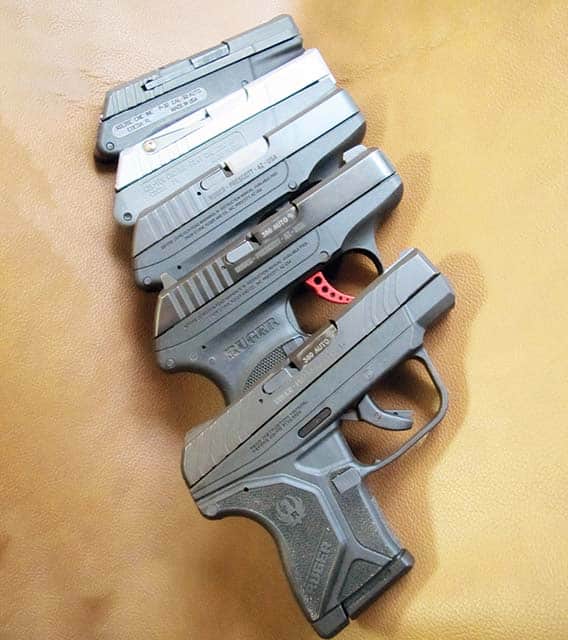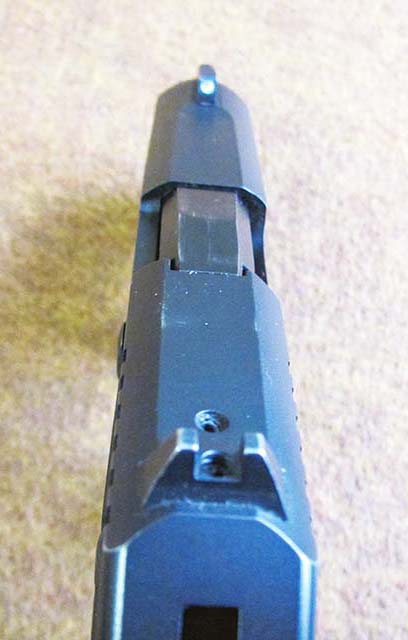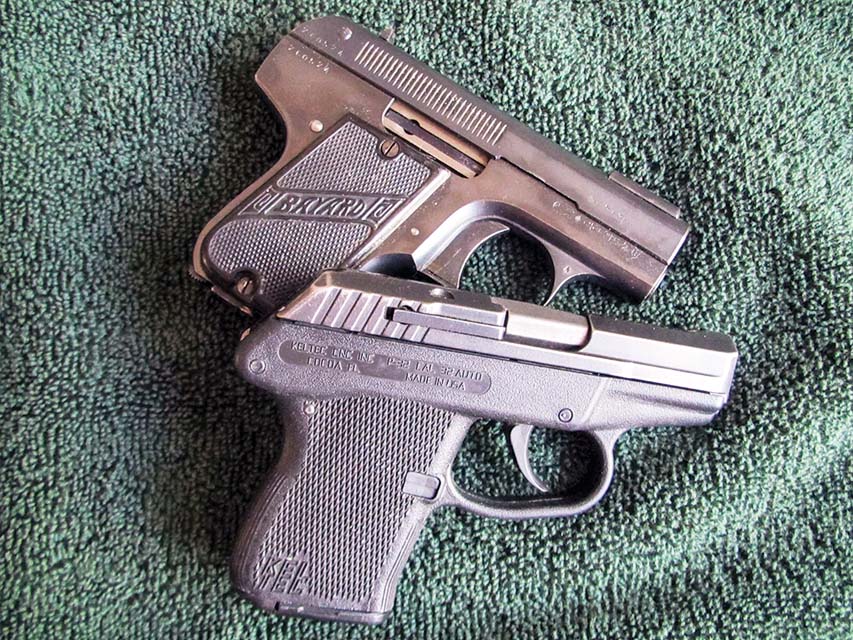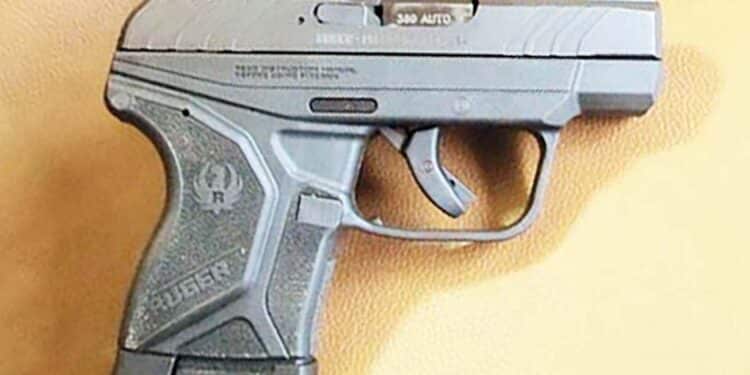Story & Photography by Aaron Brudenell
If the last true firearm innovation was the polymer frame, we’re about 50 years into the current technological drought. Like a bag of Legos, a successful gun maker must put together something that is (or appears to be) a new combination of existing ideas if it wants to be novel. Another option for success might be a new product that does something that’s been overpriced or neglected in the market. In the late 1990s KelTec CNC Industries did all three with its P32. Sturm, Ruger & Co. took note and re-designed its LCP vest pocket gun line in 2016. Here’s how they compare.

KelTec’s P32
The original KelTec P32 combined the twin innovations of lightweight polymer and aluminum materials with the well-established Browning tilting barrel recoil mechanism to make a pistol smaller, lighter and more controllable than any predecessor in the same caliber. Due to all this and the general economy that’s a hallmark of KelTec CNC, the cost was and has remained affordable.
The P32 has an empty weight of less than 8 ounces, dimensions of 0.75×3.5×5 inches and a capacity of 7 + 1. The magazine orientation is nearly vertical which makes for a compact, efficient size while allowing cartridge placement that avoids the problem of “rim-lock” with the semi-rimmed .32 ACP cartridge. Magazines are made by Mec-Gar—another brand name synonymous with reliable quality. Dual recoil springs round out the features that mitigate recoil while keeping the weight down.
The only slide stop is internal, powered by the empty magazine follower once the last shot is fired. KelTec’s P32 has no external safety controls and a sloped back slide and frame for fast, snag-free draw from a pocket or holster. The grip texture is outstanding, and the fire-control system makes use of a hammer that’s pre-charged to a half-cock position with the action of the slide. Like a GLOCK, it’s at half-cock when chambered, and the lightened DA pull weighs in around 6 or 7 pounds.
The original trigger/hammer design had one notable downside: After firing, a full release of the trigger was required for a subsequent shot. A partial release of the trigger produced a felt and audible click that can be mistaken for a traditional trigger reset. If that partially released trigger was pulled, the hammer would fall from the half-cock position. This normally causes a light strike on the cartridge primer and a failure to fire. Likewise, if a trigger pull is attempted with the slide out of battery, the trigger must be fully released once the slide is forward, or the same light hammer strike will result.
The P3AT
The sights on the original P32 were minimalist at best and remained unchanged in 2003 when KelTec released their next version—the .380 ACP! Calling it the model P3AT, the main changes were to the slide con-tour adding mass, elimination of the internal slide stop and a magazine capacity necessary reduced to 6 rounds to accommodate the larger cartridge in the same size grip. The newer, more powerful cartridge produced greater recoil, but the lower ammunition cost and increased stopping power made an attractive package that matched the sales of its predecessor.
In time, KelTec made improvements to the designs of both models. The extractor design was updated and included an external flat spring, giving the slide a distinctive look. Two removable internal parts, the ejector and the spring and guide rod seat (at the front of the slide), were eliminated so that a field strip had two fewer tiny parts to misplace. The slide was beefed up to a more blocky shape that included square post and notch sights that, while tiny, were better than the originals.


Ruger’s LCP Versions
Within 5 years of the release of the P3AT, KelTec was paid the most sincere compliment when Sturm, Ruger & Co. decided to make its own version of this highly successful pocket pistol. Ruger’s new model, the LCP®, had all of the same basic features of the P3AT with the updated cosmetic style of the Ruger P345 and SR9 models. Ruger’s pistol had the same fire control, capacity, sights and size but brought back the slide stop in a new way. This feature was external and manually operated only. The pistol can be locked open by the operator but will not do so automatically on an empty magazine. The grip texture of the LCP is less aggressive than the P32 or P3AT. This can be seen as an improvement or step backwards depending on the user’s preference.
One year into the manufacture of the LCP, Ruger decided to address the issue of the partial trigger release permitting a hammer fall. This product recall was officially intended to correct a potential safety issue, accidental discharge from a fall, but also eliminated the light strike possibility related to either a partial trigger release or out of battery trigger pull. Only the first serial number series was affected (numbers beginning with 370), and those pistols corrected by the recall were marked with a diamond-shaped stamp to the frame on the top ledge of the hammer cutout. Eventually, KelTec pistols were similarly updated.
Ruger has an excellent reputation for quality and durability, so the new LCP pistols were taken seriously and sold like hot cakes. KelTec’s slightly lower retail cost and other features like the sharper grip texture and the lower recoiling .32 ACP option kept its sales brisk as well. All of this success coincided with a widespread drought of .380 ACP ammunition availability in the U.S. around the same time.

Ruger’s next batch of improvements came in the form of the LCP Custom. This model had a polished blue finish to the sides of the slide, an aluminum trigger and substantial upgrade to the sights. The new sights were removable parts that were much taller than the original and featured a white dot in the front. Better sights fulfilled part of the goal of turning the LCP from a stubby pocket rocket into a truly accurate, shootable sidearm. The rest of this task required improvements to the trigger and grip that lead Ruger designers to the latest evolution.
Ruger’s LCP II hit the scene in 2016 and represented a more substantial re-design than those that came before. The external slide stop and magazine design were both upgraded to lock the gun open after the last shot fired. The new sights split the difference between the low-profile originals and the more usable tall versions of the Custom model. Forward slide serrations were added, and an updated grip texture coupled with a wider section to the rear half of the grip frame improved the shooter’s reaction to recoil. All of these improvements were just icing on the cake to the biggest change of all: a single-action trigger!
The LCP II employs a concealed hammer that functions with a crisp break and an even better reset for follow-up shots. With the improvements to the grip, sights and the automatic slide lock, the LCP II pistol shoots like a “real gun!” This author and others have used the LCP II in IDPA competitions with respectable results. The model enjoys back-wards compatibility with original LCP mag-azines, but those will not activate the slide stop. The wider grip has minimal impact on concealability, and the single-action trigger is supported with a trigger safety and internal safety features that prevent discharge without a pull of the trigger.
Solid Designs
Despite years of evolution, an original or current production KelTec P32 remains a viable self-defense pocket pistol that is lighter and easier to shoot than any previously comparable designs. The latest version of the Ruger LCP II offers shootability that exceeds that of anything currently available in the same size or weight. Along the path from A to B is an unbroken chain of solid designs with incremental improvements that never deviated from the innovative concept of remaking the vest pocket gun, using modern materials and the time-tested and efficient Browning recoil operating system.
| This article first appeared in Small Arms Review V24N1 (Jan 2020) |











